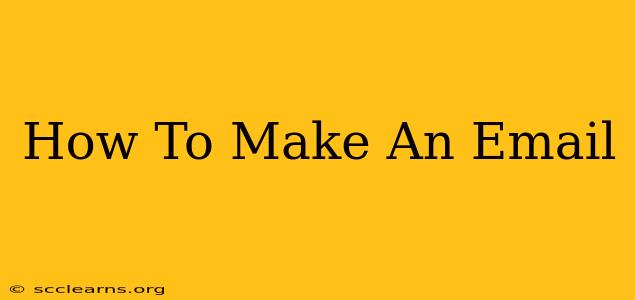Creating an effective email is more than just typing words; it's about crafting a message that gets read, understood, and acted upon. Whether you're sending a casual note to a friend or a crucial business proposal, mastering the art of email composition is a valuable skill. This guide will walk you through the process, step-by-step.
Understanding the Anatomy of an Email
Before diving into the creation process, let's examine the key components of a well-structured email:
1. The "To" Field: Targeting Your Audience
The "To" field is where you enter the recipient's email address. Accuracy is paramount here – a misspelled address leads to undelivered emails and missed opportunities. Double-check the address before hitting send!
2. The "CC" and "BCC" Fields: Sharing Information Strategically
- CC (Carbon Copy): Use the CC field to keep individuals informed without requiring direct action from them. This is useful for keeping managers updated or ensuring colleagues are aware of a conversation.
- BCC (Blind Carbon Copy): The BCC field allows you to send a copy of your email to additional recipients without revealing their email addresses to other recipients. This protects privacy and is especially useful for sending emails to large groups.
3. The Subject Line: Crafting a Compelling Hook
Your subject line is the first (and sometimes only) impression your email makes. Make it count! A strong subject line should be:
- Clear and concise: Immediately communicate the email's purpose.
- Relevant: Accurately reflect the email's content.
- Intriguing (but not misleading): Entice the recipient to open the email.
Examples:
- Good: "Meeting Confirmation: Project X Brainstorm"
- Bad: "Hey!"
4. The Salutation: Personalize Your Greeting
Choose a salutation that reflects your relationship with the recipient. Formal emails typically use "Dear Mr./Ms./Mx. [Last Name]," while informal emails might use "Hi [First Name]" or simply "Hello." Avoid generic greetings like "To Whom It May Concern" unless absolutely necessary.
5. The Body: Crafting Your Message
This is where you communicate your message. Keep it:
- Organized: Use paragraphs, bullet points, and headings to improve readability.
- Concise: Get to the point and avoid unnecessary jargon.
- Actionable: Clearly state what you want the recipient to do.
- Proofread: Errors in grammar and spelling undermine your credibility.
6. The Closing: Sign Off Appropriately
Choose a closing that matches the tone of your email. Options include:
- Formal: "Sincerely," "Respectfully," "Regards"
- Informal: "Best," "Thanks," "Cheers"
7. Your Signature: Adding Professionalism
Include a professional signature with your name, title, contact information, and possibly a website or social media link.
Types of Emails and Best Practices
Different situations call for different approaches to email writing. Here's a breakdown of common email types and tips for each:
Business Emails: Maintain professionalism, be concise, and proofread meticulously.
Personal Emails: Allow for more informality, but still strive for clarity and proper grammar.
Marketing Emails: Focus on a clear call to action and keep your email list updated and engaged. Comply with relevant regulations like CAN-SPAM.
Essential Email Etiquette
- Respond promptly: Aim to reply within 24-48 hours.
- Use a professional email address: Avoid using unprofessional or silly email addresses for business communication.
- Avoid using all caps: This is considered shouting online.
- Use proper grammar and spelling: This demonstrates respect for the recipient's time.
- Be mindful of attachments: Ensure attachments are relevant and not excessively large.
By following these steps and incorporating these best practices, you'll be well on your way to mastering the art of email creation and crafting effective, engaging messages every time. Remember, clear communication is key to successful email writing.

